Iranian MP Criticizes Government For Not Releasing Allocated Budget

An Iranian lawmaker says the administration has not yet paid a single rial of the development and infrastructure budget for the current Iranian year, started on March 21.

An Iranian lawmaker says the administration has not yet paid a single rial of the development and infrastructure budget for the current Iranian year, started on March 21.
Kamal Hosseinpour, the representative of Sardasht in the West Azarbaijan province in the parliament, said on Friday that over four months have passed since the beginning of the year but the government has not provided the allocated budget for the construction projects of the province.
Criticizing the mismanagement of the budget allocations, he said, “The Plan and Budget Organization of the country tells us that we don't have money and it's like they don't have any plan for their work, they don't even provide technical details.”
He added that in many parts of the country only one to two months are left of the construction season due to the cold season approaching but no money has been released yet.
They do not complete important projects such as the sewage treatment plant in the city of Rabat near Sardasht, where the sewage water of 20,000 people enters the dam that supplies the city’s drinking water, the lawmaker complained.
Earlier in the month, the Supreme Accounting Office released a report covering the period March 21- May 20 that shows government facing a serious problem in collecting revenues. Except tax revenues, all other major sources of income, including oil exports, grossly underperformed, which local media said was a serious warning for the government and the economy.
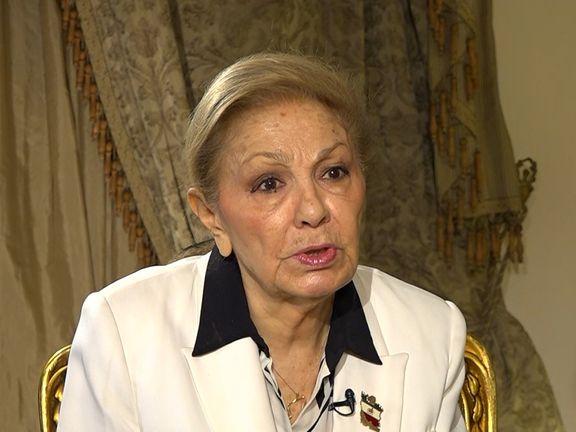
Iran’s exiled Queen has applauded Iranian women seeking justice for loved ones killed in anti-government protests and those who are fighting compulsory hijab.
“My dear sisters and children, I'm aware of the hardships you are going through and I'm proud of your courage and power in seeking freedom,” the exiled Queen Farah Pahlavi said in a video message obtained by Iran International referring to the escalation of government pressure on ‘Mothers for Justice’ and violence against anti-hijab activists and protesters.
The group of activist mothers whose children were killed by the government during anti-government protests in recent years has come to be known as ‘Mothers for Justice’. They have tried to keep the memory of their loved ones alive while relentlessly calling for justice for them despite intimidation, harassment, arrests and even prison. ‘Mothers for Justice’ have also been supportive of women's rights campaigns and the anti-hijab movement.
“You and your families are in my thoughts. I hope that Iran will be freed, in the same way that you want it to be freed, and particularly that you are freed [from oppression] yourselves,” the former Queen of Iran said in her message.
The movement against compulsory hijab has picked up pace in the past few weeks following the harsh crackdown on ‘bad-hijab women’ by the ‘Morality Police’ and extra measures ordered by authorities, including denying service to women who do not fully comply with hijab rules at government offices, banks, and public transportation.
On July 12, following a call by women’s rights activists for civil disobedience with the hashtag of ‘No2Hijab’ social media exploded with dozens of videos and photos of women unveiling in public.
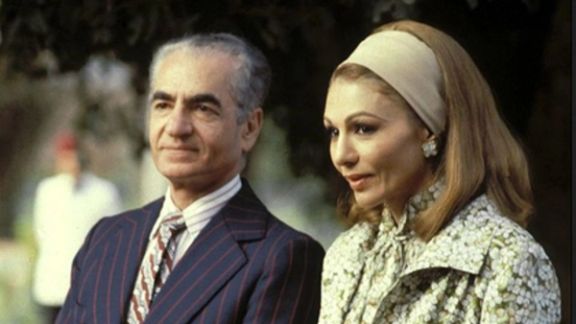
In another statement released on Sunday, the exiled Queen condemned the widespread arrests of civil and human rights activists in Iran, particularly the anti-hijab activists. Denouncing the violent behavior of the morality police’s hijab enforcement patrols (Gasht-e Ershad) and the arrest of anti-hijab activists and protesters, she said in her statement that the civil struggle of Iranian women and men against all forms of coercion and discrimination is a “source of pride and honor.”
Farah Pahlavi, who married Mohammad Reza Shah at the age of 21 in 1959, is 83 years old and lives in Paris. She has come to be seen by many Iranians as a respected elder who contributed to the realization of women’s rights during the secular monarchy.
“Today, Iran has stood up and despite [government] killings in streets, repression, prisons, torture and executions, Iranian freedom fighters, Iran's unique women, alongside men, have not hesitated in conveying their outrage at the regime's leaders to the world,” she said Wednesday in another message on the 42nd death anniversary of her husband, King Mohammad Reza Shah Pahlavi, who was ousted by the Islamic Revolution of 1979.
In recent years as economic crisis and heavy-handed policies by the Islamic Republic have worsened, many Iranians have come to praise the Pahlavi dynasty for modernizing the country in the 20th century and have chanted slogans praising the Pahlavi monarchs during anti-government protests.
The former crown prince, Reza Pahlavi, has on several occasions said that he is not seeking to return to power but in his messages to the nation over the waves of protests in the country in the past few years he has repeatedly called for a coordinated front to organize anti-government activities.
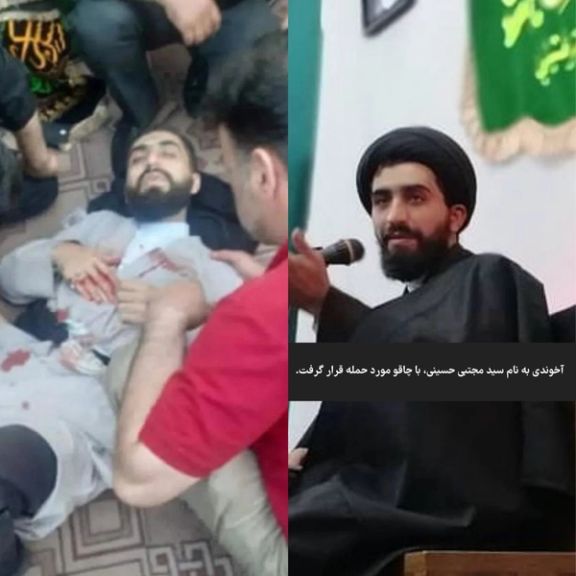
An Iranian cleric named Mojtaba Hosseini has been stabbed several times in his back during his sermon in the city of Karaj in Western Tehran, according to a local official.
Morteza Mousavi, the deputy police commander of Alborz province close to the capital, said on Friday that the assault happened Thursday evening. He was taken to the hospital and is now in stable condition.
The attacker was only identified as an Iranian and a self-proclaimed follower of Muhammad al-Mahdi, believed by the Twelver Shiites to be the last of the Imams and the eschatological Mahdi, who will emerge in the end of time to establish peace and justice and redeem Islam.
Several Iranian clerics have come under attack by angry Iranians recently as rising prices and constant protests have led to a tense environment in the country.
Earlier in July, a congregational prayer imam was injured in an assassination attempt by an assailant on a motorcycle in the city of Esfahan.
In early June, the representative of Iran’s Supreme Leader in the central city of Esfahan was attacked by a young man carrying a knife. And in April, a man stabbed three clerics in Iran's largest Shiite shrine in Mashhad, killing two of them.
Earlier in the year, a senior Islamic scholar said that clerics and seminary students are avoiding their usual garb for fear of being insulted in public, as the people in Iran blame the clergy for the current hardships they experience, including high prices and corruption. Another well-known cleric also talked about the growing hatred and grudge towards the clergy in January, warning of a crisis unfolding in society.
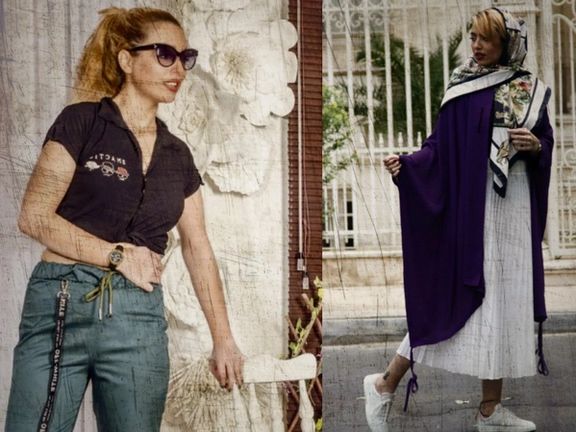
Iranian state media affiliated with the Revolutionary Guards are publishing forced video confessions from women who are arrested over their participation in an ongoing anti-hijab campaign.
Fars news website, with close links to the IRGC, published a video this week of a woman, identified as Elham Farshad, who confessed that she was angry, and insulted a clergyman who was admonishing her over her hijab. In the video she was remorseful and expressed regret.
According to information obtained by Iran International, agents of the Intelligence Ministry arrested Farshad at his home on July 13, and transferred her to the Ward 209 of Evin Prison, a detention center controlled by the ministry. After ten days, she was released from prison with a bail of 5 billion rials (about $17,000), after they filmed her confessing to wrongdoing under duress.
An informed source told Iran International that the woman who was forced to confess in the video was not Rashno and that the video is the confessions of another woman on the bus who got into a fight with the hijab enforcer and got her hand injured.
Iran’s security organs have also started arresting women who participated in a nationwide civil disobedience campaign against hijab on July 12 and sent videos to US-based women’s rights activist Masih Alinejad.
Following a call by women’s rights activists for civil disobedience with the hashtag of ‘No2Hijab’ social media exploded with dozens of videos and photos of women unveiling in public.
In the past few weeks, the government has increased harassment of women for their insufficient hijab and many have been detained by special police patrols.
Iran’s Supreme Leader claimed Wednesday that the anti-hijab movement is nothing but a Western plot, much like his depiction of all problems as plots by enemies.
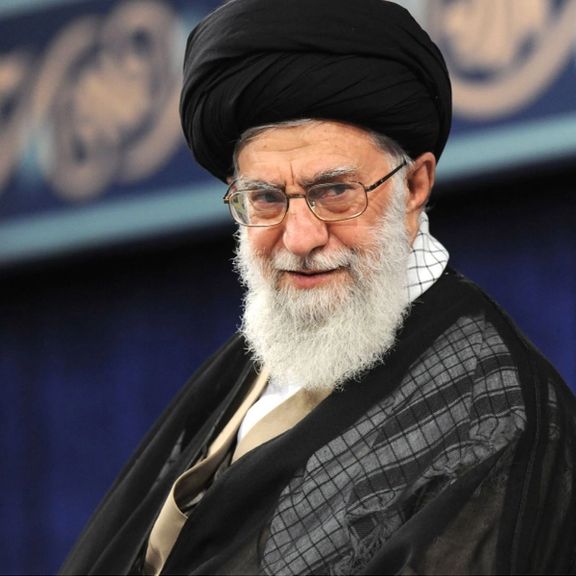
The US special envoy to monitor and combat antisemitism has decried remarks by Iran’s Supreme Leader Ali Khamenei, describing them as “unacceptable and dangerous.”
In a tweet on Thursday, Deborah Lipstadt said, “We denounce this continued, egregious antisemitism,” adding that “This rhetoric is unacceptable – not to mention dangerous – especially from a head of state.”
Calling on the Islamic Republic to end its antisemitic stance towards the world, she said, “It must cease.”
She was replying to a tweet by Khamenei’s official account who said a day earlier, July 27, that described the Western powers as “mafia,” noting that “At the top of this mafia stand the prominent Zionist merchants, and the politicians obey them. The US is their showcase, and they’re spread out everywhere.”
His remarks came as tensions have been simmering between Iran and Israel in the recent weeks with Israel making alliances with the regional countries against the Islamic Republic and Tehran claiming that it has dealt severe blows to Israel without mentioning any concrete event.
Earlier in the week, Israel’s envoy to the United Nations Gilad Erdan told Iran International that Iran is enriching uranium almost to military-grade, noting that “This is a clear threat to the security of our region and to the whole world. It needs to be addressed by this Security Council, and this Council is silent.”

Ground collapse in the heart of the capital Tehran Thursday once again highlighted the many dangers that Iran’s industrial and financial center may be facing.
According to local media the ground collapsed at 7:40 in Sepah Ave in central Tehran. Chief of Tehran police information center, Ali-Asghar Sharifi, told the media that police and other authorities were working at the scene to secure the area and redirect traffic. The incident had no casualties.
There have long been concerns about earthquakes in Tehran as it sits on tectonic fault lines. Ground subsidence, however, resulting from drought and excessive extraction of water which is likely to become more serious in the future adds a new concern and danger to the densest population center in Iran.
Ground subsidence in urban areas can result in power outages, bursting of gas pipes, deformation of rails, emergence of sinkholes, tilting of buildings, and appearance of cracks and ditches in roads and even loss of human life.
Mohammad Aghamiri, chairman of Tehran City Council’s development committee on Thursday described ground subsidence as a time bomb ticking under the city and criticized the authorities for only watching idly without taking any measures to prevent disaster from happening.
This is not the first instance of ground subsidence in Tehran where smaller fractures and cracks are quickly becoming common in some areas of the city, particularly south and southwest.
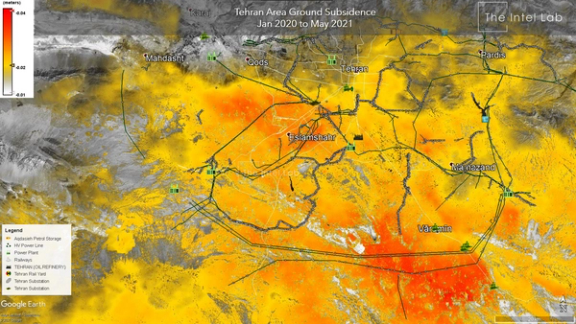
According to the latest official data by Iran’s Geological Organization, the rate of subsidence in the plains around Tehran was between 17 and 24 centimeters per year. The deputy chairman of the environment committee of Tehran City Council, Mehdi Babaei, said recently that ground has subsided by as much as 20 centimeters (8 inches) a year near Shahriyar in southern Tehran.
Ali Saberi, a geologist told local media in 2021 that one million hectares of land in the country is affected by subsidence and the main cause is unlimited extraction of ground water.
Intel Lab intelligence and imagery consulting firm in July 2021 said a brief study it had conducted based on a dataset of 14 pairs of satellite images showing various areas of Greater Tehran indicated a maximum average subsidence rate of 4 centimeters/year.
Huge cracks and hollows that resemble meteor craters have appeared in other parts of the country. In urban areas subsidence has caused cracks in walls and in roads.
One of the most affected areas is the historical city of Esfahan in central Iran where the damage to monuments and the international airport have been cause of much concern.There are photos on social media of huge cracks in the ground around the airport, and of hollows in and around Esfahan’s historical buildings.
Iran has been experiencing consecutive droughts for more than a decade in addition to what many lawmakers and journalists have called years of water mismanagement. Illegal deep wells drilled all over the country for irrigation of agricultural land have depleted underground water reserves in many areas.
Alireza Shahidi, head of Iran’s Geological Organization said in March that land subsidence is a “silent earthquake” that can lead to political and security crises.